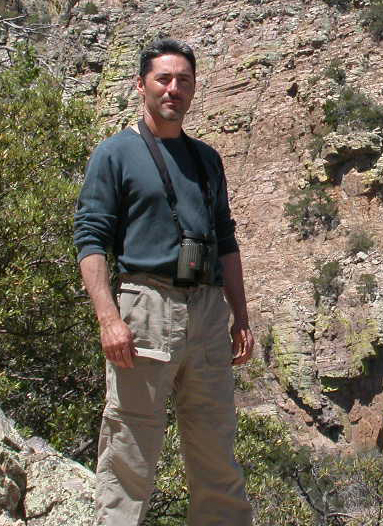2 June 2013
James Holdsworth, Frank Pinilla, Richard Skevington and I were honoured to be the Ontario Field Ornithologists’ celebrity birders in this year’s birdathon. With your help, about $3000 was raised. Twenty-five percent of this goes to support the OFO and the rest goes to Bird Studies Canada to support their programs. We decided to conduct our Big Day in the Durham region, with a late day trip to Carden to round out the list. We dedicated May 23rd and 24th to scouting and did our count on Saturday May 25th. Frank spent a lot of time digging for records and asking people for suggestions on where to find the more difficult species before the scouting even began. We would like to thank Dennis Barry, Geoff Carpentier, Tyler Hoar, Rayfield Pye and Ron Tozer for providing us with details on some of the more tricky to find birds.
Weather for our scouting days and the Big Day was far from optimal. After several warm days with excellent migration, a cold front arrived on May 23rd and the temperature dropped like a stone while the wind whipped around to the north at 25-50 kph. This trend continued for several days and nearly halted migration while also reducing song from local birds and making it hard to hear the ones that were singing. Given that we had work obligations on the 27th, we had to take what we had and work with it. All of the scouting and preparations along with slightly improved conditions on the 25th saved us but we really had to dig hard for many of the expected easy species. We had chosen the 25th as our target date partly because all of the regular breeders are back while migration is still going but also because there was a full moon that night. We got lucky and the night was clear. This meant that despite near zero temperatures and moderate winds, bird song was quite intense at wetlands that we visited during the night.
We started at midnight at Saintfield (=Reach) Marsh. The marsh was alive with song. The dominant chorus of Marsh Wrens was supplemented by several Virginia Rails, Sora, Common Gallinule, American Bittern, Wilson’s Snipe, American Woodcock, Common Yellowthroats, Swamp Sparrows and a Great Horned Owl that was silhouetted in a dead tree as it called frequently. One of my favourite things about Big Days is that it gets me out into these settings in the middle of the night. Wetlands are such spectacular places to be on a bright moonlit night when everything is singing. After an enjoyable 40 minutes, we moved on to a nearby wetland on Old Simcoe Road where we added Green Heron, Alder Flycatcher and our first of two unexpected Long-eared Owls. We then made a quick stop along highway 7A at Lake Scugog. Traffic was heavy but we managed to hear a Least Bittern singing in a brief silence between cars. Migrant Gray-cheeked Thrushes heard along Pickering/Uxbridge Townline Road at 2:45am were encouraging, as we had not expected migrants to move with the strong north winds. We arrived at Cranberry Marsh at 3:20 and added several species that we saw again later in the day (Mute Swan, Trumpeter Swan, Gadwall, American Wigeon, Mallard, Green-winged Teal, Least Sandpiper, Dunlin and Ring-billed Gull). Many of these were visible and easily identifiable in the bright moonlight. After leaving Cranberry Marsh we spent about an hour looking for Eastern Screech-Owls in the Courtice area. We finally scored at 4:30am at the last site we were planning to check. Screech owls are remarkably scarce in Durham Region so we were elated to find this bird. We did not find Barred and Northern Saw-whet Owls during the night so we crossed our fingers that we would find them at Carden in the evening.
The dawn chorus was just getting started as we arrived at Darlington Provincial Park at 5:00am. Darlington was certainly one of the highlights of our day as we took our time and spent nearly 4 hours here making sure that we saw as many migrants as possible. We recorded 93 species at Darlington, including the following highlights: 5 Long-tailed Ducks, 1 Common Goldeneye, 55 Common Loons (migrants on the move), an Osprey, 15 Semipalmated Plovers, the male Piping Plover that had been in the area for several days, a Lesser Yellowlegs, 40 Whimbrel, a Ruddy Turnstone, 25 Semipalmated Sandpipers, 8 Least Sandpipers, 100 Dunlin, 5 Bonaparte’s Gulls, a lingering second summer Iceland Gull that we found during scouting, 3 Caspian Terns, 1 Merlin, 1 Yellow-bellied Flycatcher, 5 Willow Flycatchers, 1 Philadelphia Vireo, all of the expected swallows except Purple Martin, 1 Red-breasted Nuthatch, 3 Blue-gray Gnatcatchers, 5 Golden-crowned Kinglets, another Gray-cheeked Thrush, 1 Swainson’s Thrush, 1 Northern Mockingbird and 16 species of warblers including Tennessee, Orange-crowned, Blackburnian, Blackpoll, Pine, Yellow-rumped, Canada and Wilson’s. Many of the warblers were in a single flock along the SE edge of the park in the sun in the lee of the wind where there were lots of midges to eat.
We reluctantly moved on from Darlington and made a quick stop at Second Marsh where we added: 3 Northern Shoveler, 1 Bald Eagle, 1 White-rumped Sandpiper, 2 Common Terns and our first of 4 Orchard Orioles. Thickson’s Woods was very quiet but we added our only Belted Kingfisher, Downy Woodpecker(!) and House Finch(!!) of the day as well as Least Flycatcher and Cedar Waxwings. We quickly moved on to Cranberry Marsh where we saw a remarkable group of three male Eurasian Wigeon. Other highlights here were our only Redhead, Ring-necked Pheasant, Sharp-shinned Hawk and American Coot of the day. The pheasant and Sharpie were completely unexpected. We thought that the former had disappeared from the site and the Sharp-shin appeared as part of a small hawk migration that was getting started. It would have been interesting to stick around to see what other raptors appeared over the course of the day but we moved on quickly to Whitby Harbour where we added Purple Martins and American Kestrel to our list. We missed the Peregrine that we had seen here while scouting and overall were disappointed that we did not find any good gulls or other interesting non-passerines (Brant, Great Black-backed, Lesser Black-backed and Little Gulls had all been seen here recently).
Whitby was our last lakeshore stop and at this point we happily left the building traffic and headed inland. Our first inland stop was on a nice overlook on Chalk Lake Road where we had good luck with raptors during our scouting. We were in luck here and quickly added Cooper’s Hawk, Red-shouldered Hawk and Common Raven along with Horned Lark, Eastern Bluebird and Bobolink. Quick stops for Grasshopper Sparrow and Clay-colored Sparrow turned up only the former but both were insurance stops only as we saw many of each at Carden later in the day. We then twitched the only Hooded Warbler on our route (the Westney Road bird). We rushed into the site, heard it chipping, and then rushed back to the car. Wood Thrush, Mourning Warbler and Black-throated Blue Warblers were other new birds for our day from this lovely hardwood forest site. A quick run into Glen Major secured Blue-winged Warbler and we were off again. We had scouted an area on Bradburn Road for Red-headed Woodpeckers and on our way there found another pair, saving us 5 to 10 minutes. Our next stop was the Osler Tract Swamp, a new area to us that we had really enjoyed during scouting (thanks Tyler!). Unfortunately it was 2:15pm when we arrived and the afternoon doldrums had kicked in. Nothing was singing and we missed several of our targets here but did manage to secure our primary target and highlight of the day – a very angry female Northern Goshawk that escorted us off her territory as she had done during scouting. She provided crippling views as she dove at us before perching on a dead stub 20m away calling and fluffing her undertail coverts and hackles.
Nonquon Sewage Lagoons at Port Perry are a mainstay of any big day in Durham but had been disappointing during scouting due to high water levels. They were OK though and we picked up Bufflehead, Ruddy Duck, an impressive flock of 180 Black Terns and our only really unexpected, unscouted rarity of the day, a Red-necked Phalarope. We received one birdathon t-shirt from Bird Studies Canada for our efforts and had agreed that the spotter of the most unexpected bird of the day would get the shirt. My Dad won the t-shirt after spotting the phalarope. I’m not sure I have ever seen him wear a t-shirt!
We then motored off towards Carden where the new birds came fast: Northern Harrier, Upland Sandpiper, Eastern Meadowlark, Pileated Woodpecker, Greater Yellowlegs, Loggerhead Shrike, Veery (a relief to finally get one!), Hermit Thrush (double the relief), Golden-winged Warbler, Savannah Sparrow (triple relief), Black-billed Cuckoo, Scarlet Tanager (more relief) and Purple Finch. As dusk approached the night birds that make Carden such a special place really kicked into gear. We heard at least 6 different Barred Owls, 5 Common Nighthawks, 10+ Eastern Whip-poor-wills (including each of a male & female on the road in our headlights) and 2 Northern Saw-whet Owls finished off our day at about 11:45 pm. We had not taken time to scout Carden so we missed a few species, including the dependable Prairie Warbler. Next time we will be sure to take time to scout Carden ahead of time. An extra day exploring this fabulous area is certainly no hardship.
We had not expected to exceed our target of 170 species with the weather we had so we were very pleased to finish our day with 177 species. Raptors really lead the count with 9 hawk and 5 owl species. We covered 397 km by car and about 10 km by foot, a modest amount of travel for a Big Day that undoubtedly added to our enjoyment of the day. Thanks to all of you who sponsored us in this endeavour and thanks to OFO for asking us to take on this challenge. We had a lot of fun and are looking forward to our next Big Day experience.



